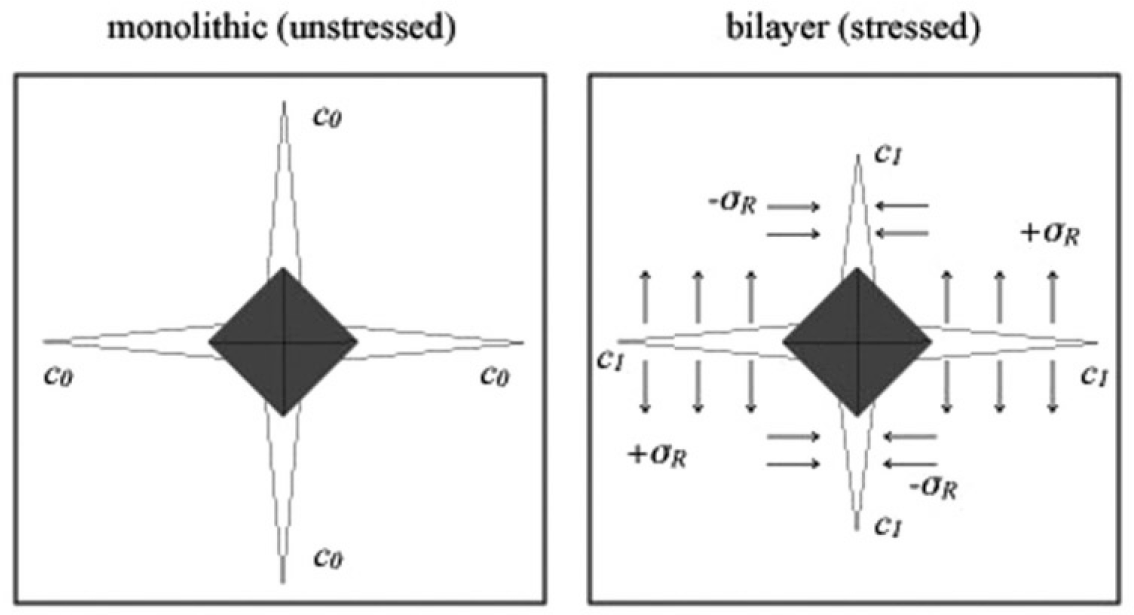Abstract
Nowadays, dental zirconia is widely used as a framework material for a fixed dental prosthesis as well as a single restoration. However, clinical studies have reported high incidence of veneer chipping of zirconia-ceramic restorations compared to that of metal-ceramics. Several factors were raised as the possible causes of veneer ceramic chipping, however, it is still in debate. Recently, residual stresses in the veneer ceramics after cooling process gathers attention as one possible cause of chipping and many studies reported that the rate of cooling significantly influenced the types and the amount of residual stress. The purpose of current review was to briefly describe the effect of cooling rate on the residual stress in zirconia-ceramics. It was also described that the different behavior of residual stress between zirconia-ceramics and metal-ceramics following different cooling rate. (J Korean Acad Prosthodont 2014;52:136-42)
Go to : 
REFERENCES
1.Guess PC., Schultheis S., Bonfante EA., Coelho PG., Ferencz JL., Silva NR. All-ceramic systems: laboratory and clinical performance. Dent Clin North Am. 2011. 55:333–52.

2.Christensen RP., Ploeger BJ. A clinical comparison of zirconia, metal and alumina fixed-prosthesis frameworks veneered with layered or pressed ceramic: a three-year report. J Am Dent Assoc. 2010. 141:1317–29.
3.Kelly JR., Benetti P. Ceramic materials in dentistry: historical evolution and current practice. Aust Dent J. 2011. 56:84–96.

4.Molin MK., Karlsson SL. Five-year clinical prospective evaluation of zirconia-based Denzir 3-unit FPDs. Int J Prosthodont. 2008. 21:223–7.
5.Sorrentino R., De Simone G., Tete` S., Russo S., Zarone F. Five-year prospective clinical study of posterior three-unit zirconia-based fixed dental prostheses. Clin Oral Investig. 2012. 16:977–85.

6.Sailer I., Gottnerb J., Kanelb S., Hammerle CH. Randomized controlled clinical trial of zirconia-ceramic and metal-ceramic posterior fixed dental prostheses: a 3-year follow-up. Int J Prosthodont. 2009. 22:553–60.
7.Sailer I., Pjetursson BE., Zwahlen M., Ha¨mmerle CH. A systematic review of the survival and complication rates of all-ceramic and metal-ceramic reconstructions after an observation period of at least 3 years. Part II: Fixed dental prostheses. Clin Oral Implants Res. 2007. 18:86–96.

8.Rinke S., Gersdorff N., Lange K., Roediger M. Prospective evaluation of zirconia posterior fixed partial dentures: 7-year clinical results. Int J Prosthodont. 2013. 26:164–71.

9.Sax C., Ha¨mmerle CH., Sailer I. 10-year clinical outcomes of fixed dental prostheses with zirconia frameworks. Int J Comput Dent. 2011. 14:183–202.
10.Burke FJ., Crisp RJ., Cowan AJ., Lamb J., Thompson O., Tulloch N. Five-year clinical evaluation of zirconia-based bridges in patients in UK general dental practices. J Dent. 2013. 41:992–9.

11.Koenig V., Vanheusden AJ., Le Goff SO., Mainjot AK. Clinical risk factors related to failures with zirconia-based restorations: an up to 9-year retrospective study. J Dent. 2013. 41:1164–74.

12.Aboushelib MN., Feilzer AJ., Kleverlaan CJ. Bridging the gap between clinical failure and laboratory fracture strength tests using a fractographic approach. Dent Mater. 2009. 25:383–91.

13.Aboushelib MN., Kleverlaan CJ., Feilzer AJ. Effect of zirconia type on its bond strength with different veneer ceramics. J Prosthodont. 2008. 17:401–8.

14.Guess PC., Kulis A., Witkowski S., Wolkewitz M., Zhang Y., Strub JR. Shear bond strengths between different zirconia cores and veneering ceramics and their susceptibility to thermocycling. Dent Mater. 2008. 24:1556–67.

15.Go¨stemeyer G., Jendras M., Dittmer MP., Bach FW., Stiesch M., Kohorst P. Influence of cooling rate on zirconia/veneer interfacial adhesion. Acta Biomater. 2010. 6:4532–8.
16.Guess PC., Bonfante EA., Silva NR., Coelho PG., Thompson VP. Effect of core design and veneering technique on damage and reliability of Y-TZP-supported crowns. Dent Mater. 2013. 29:307–16.

17.Silva NR., Bonfante EA., Rafferty BT., Zavanelli RA., Rekow ED., Thompson VP., Coelho PG. Modified Y-TZP core design improves all-ceramic crown reliability. J Dent Res. 2011. 90:104–8.

18.Guazzato M., Walton TR., Franklin W., Davis G., Bohl C., Klineberg I. Influence of thickness and cooling rate on development of spontaneous cracks in porcelain/zirconia structures. Aust Dent J. 2010. 55:306–10.

19.Mainjot AK., Schajer GS., Vanheusden AJ., Sadoun MJ. Influence of cooling rate on residual stress profile in veneering ceramic: measurement by hole-drilling. Dent Mater. 2011. 27:906–14.

20.Rues S., Kro¨ger E., Mu¨ller D., Schmitter M. Effect of firing protocols on cohesive failure of all-ceramic crowns. J Dent. 2010. 38:987–94.

21.Anusavice KJ., DeHoff PH., Hojjatie B., Gray A. Influence of tempering and contraction mismatch on crack development in ceramic surfaces. J Dent Res. 1989. 68:1182–7.

22.Swain MV. Unstable cracking (chipping) of veneering porcelain on all-ceramic dental crowns and fixed partial dentures. Acta Biomater. 2009. 5:1668–77.

23.Tholey MJ., Swain MV., Thiel N. Thermal gradients and residual stresses in veneered Y-TZP frameworks. Dent Mater. 2011. 27:1102–10.

24.Meira JB., Reis BR., Tanaka CB., Ballester RY., Cesar PF., Versluis A., Swain MV. Residual stresses in Y-TZP crowns due to changes in the thermal contraction coefficient of veneers. Dent Mater. 2013. 29:594–601.

25.Bonfante EA., Rafferty BT., Silva NR., Hanan JC., Rekow ED., Thompson VP., Coelho PG. Residual thermal stress simulation in three-dimensional molar crown systems: a finite element analysis. J Prosthodont. 2012. 21:529–34.

26.DeHoff PH., Anusavice KJ. Viscoelastic stress analysis of thermally compatible and incompatible metal-ceramic systems. Dent Mater. 1998. 14:237–45.

27.Marshall DB., Lawn BR. An indentation technique for measuring stresses in tempered glass surfaces. J Am Ceram Soc. 1977. 60:86–7.

28.Belli R., Monteiro S Jr., Baratieri LN., Katte H., Petschelt A., Lohbauer U. A photoelastic assessment of residual stresses in zirconia-veneer crowns. J Dent Res. 2012. 91:316–20.

29.Mainjot AK., Schajer GS., Vanheusden AJ., Sadoun MJ. Residual stress measurement in veneering ceramic by hole-drilling. Dent Mater. 2011. 27:439–44.

30.Anusavice KJ., Hojjatie B. Effect of thermal tempering on strength and crack propagation behavior of feldspathic porcelains. J Dent Res. 1991. 70:1009–13.

Go to : 




 PDF
PDF ePub
ePub Citation
Citation Print
Print



 XML Download
XML Download